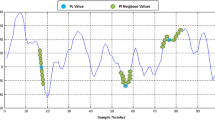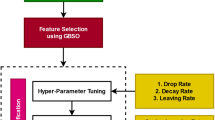Abstract
Epileptic seizure (ES) is caused due to the unpredictable and imbalanced discharge of electric signals causing a muscle ruptures. The instance is critical if unattended medically. In the proposed paper, a feature optimization and classification technique is discussed. The technique is based on the dynamic feature set extraction and producing cluster based on categorization labels. The technique is structured on grey-wolf optimization algorithm in identifying the highlighted feature–attribute co-relationship. The technique has processed attribute inter-connectivity coordinates in creating a virtual mapping and labeling of cluster-heads to provide seizure severity. The technique has successfully adopted multi-dimensional datasets for improved performance and calibration under inter-dependent attribute-feature mapping. The technique has achieved 96.76% accuracy on trained datasets with 98.76% sensitivity and 97.86% in precision on epileptic seizure classification for decision-making.






Similar content being viewed by others
References
Stafstrom CE, Carmant L. Seizures and epilepsy: an overview for neuroscientists. Cold Spring Harb Perspect Med. 2015;5(6):a022426.
Rasheed K, Qayyum A, Qadir J, Sivathamboo S, Kwan P, Kuhlmann L, O’Brien T, Razi A. Machine learning for predicting epileptic seizures using EEG signals: a review. IEEE Rev Biomed Eng. 2020;14:139–55.
Iasemidis LD. Epileptic seizure prediction and control. IEEE Trans Biomed Eng. 2003;50(5):549–58.
Shoeibi A, Khodatars M, Ghassemi N, Jafari M, Moridian P, Alizadehsani R, Panahiazar M, et al. Epileptic seizures detection using deep learning techniques: a review. Int J Environ Res Public Health. 2021;18(11):5780.
Fathima SN, Rekha KB, Safinaz S, Ahmed ST. Epileptic seizure classification and prediction model using fuzzy logic-based augmented learning. Int J Fuzzy Syst Appl (IJFSA). 2022;11(3):1–15.
Adan G, Mitchell JW, Ziso B, Larner AJ. Diagnosis and management of seizures in neurodegenerative diseases. Curr Treat Options Neurol. 2021;23(1):1–12.
Neuß F, von Podewils F, Wang ZI, Süße M, Zettl UK, Grothe M. Epileptic seizures in multiple sclerosis: prevalence, competing causes and diagnostic accuracy. J Neurol. 2021;268(5):1721–7.
Ahmed ST, Sankar S. Investigative protocol design of layer optimized image compression in telemedicine environment. Procedia Computer Sci. 2020;167:2617–22.
Shoeibi A, Ghassemi N, Khodatars M, Jafari M, Moridian P, Alizadehsani R, Khadem A et al. Applications of epileptic seizures detection in neuroimaging modalities using deep learning techniques: methods, challenges, and future works. arXiv preprint arXiv:2105.14278 (2021)
Ahmed ST, Patil K, An investigative study on motifs extracted features on real time big-data signals. In 2016 International Conference on Emerging Technological Trends (ICETT), pp. 1–4. IEEE, 2016
Shoeibi A, Ghassemi N, Alizadehsani R, Rouhani M, Hosseini-Nejad H, Khosravi A, Panahiazar M, Nahavandi S. A comprehensive comparison of handcrafted features and convolutional autoencoders for epileptic seizures detection in EEG signals. Expert Syst Appl. 2021;163: 113788.
Akyol K. Stacking ensemble based deep neural networks modeling for effective epileptic seizure detection. Expert Syst Appl. 2020;148: 113239.
Kumar Raja DR, Hemanth Kumar G, Basha SM, Ahmed ST. Recommendations based on integrated matrix time decomposition and clustering optimization. Int J Perform Eng. 2022;18(4):298.
Abiyev R, Arslan M, Idoko JB, Sekeroglu B, Ilhan A. Identification of epileptic EEG signals using convolutional neural networks. Appl Sci. 2020;10(12):4089.
Funding
No funding was received for this research.
Author information
Authors and Affiliations
Corresponding author
Ethics declarations
Conflict of interest
No conflict of interest.
Additional information
Publisher's Note
Springer Nature remains neutral with regard to jurisdictional claims in published maps and institutional affiliations.
This article is part of the topical collection “Advances in Computational Approaches for Image Processing, Wireless Networks, Cloud Applications and Network Security” guest edited by P. Raviraj, Maode Ma and Roopashree H R.
Rights and permissions
Springer Nature or its licensor (e.g. a society or other partner) holds exclusive rights to this article under a publishing agreement with the author(s) or other rightsholder(s); author self-archiving of the accepted manuscript version of this article is solely governed by the terms of such publishing agreement and applicable law.
About this article
Cite this article
Thanuja, K., Shoba, M. & Patil, K. Epileptic Seizure Classification and Feature Optimization Technique Using Grey Wolf Algorithm on Dynamic Datasets. SN COMPUT. SCI. 4, 311 (2023). https://doi.org/10.1007/s42979-023-01741-0
Received:
Accepted:
Published:
DOI: https://doi.org/10.1007/s42979-023-01741-0




